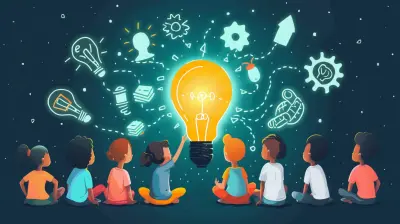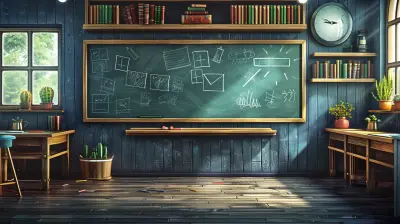The Role of Reflection in Teacher Growth and Improvement
24 May 2025
As teachers, we spend a lot of time focusing on our students—designing lessons, grading papers, managing classrooms, and mentoring. But how often do we pause and reflect on our own teaching practices? It’s easy to get stuck in the hustle and bustle of daily classroom life, but taking a step back to reflect can be one of the most powerful tools for personal and professional growth. In fact, reflection is key to improving teaching effectiveness and fostering continuous development.
So, what exactly does reflection look like in the context of teaching? How does it contribute to teacher growth and improvement? Let's dive into these questions and explore the significant role of reflection in the life of a teacher.

What is Reflection?
Before we get into why reflection is important, let’s first define it. Reflection is the process of looking back on your actions, experiences, and outcomes to analyze what went well and what didn’t. When applied to teaching, it allows educators to assess their teaching strategies, classroom management, lesson delivery, and overall effectiveness.It’s like holding up a mirror to your teaching practices, taking a good, hard look at how things are going, and making adjustments to improve. Reflection isn’t just about identifying what went wrong; it’s also about acknowledging successes and figuring out how to build on them.
In short, reflection helps teachers become more self-aware, which is the first step toward meaningful improvement.

Why is Reflection Important for Teachers?
1. Promotes Continuous Improvement
Teaching is a profession that is constantly evolving. New technologies, research, and educational methods are always emerging, and teachers need to adapt. Reflecting on your teaching helps you identify areas where you can grow and improve. It encourages you to stay curious and open to new ideas.Think about it this way: If you’re driving a car and never check your rearview mirror, how will you know if there’s a better route or if you're headed in the right direction? Reflection acts as that rearview mirror—it allows you to assess where you’ve been and decide how to move forward.
2. Boosts Self-Awareness
As a teacher, self-awareness is crucial. Reflecting on your teaching methods helps you understand your strengths and weaknesses. Maybe you realize that your lectures are engaging, but your assessments don’t quite measure student understanding. Or perhaps you notice that your classroom management strategies work well with some students but not with others.By becoming more self-aware, you can make intentional, informed decisions about how to improve your teaching. And the more you reflect, the better you get at recognizing patterns and making adjustments that lead to better outcomes for both you and your students.
3. Empowers Teachers to Take Ownership of Their Growth
Professional development workshops and in-service training are great, but they often provide one-size-fits-all solutions. Reflection, on the other hand, is highly personalized. It allows you to take control of your growth by focusing on the areas that are most relevant to your teaching context.When you reflect, you’re not just passively absorbing information; you’re actively engaging with your own experiences to create a roadmap for improvement. This sense of ownership is empowering and leads to more meaningful, lasting growth.
4. Supports Better Student Outcomes
At the end of the day, the goal of teaching is to help students succeed. When teachers take the time to reflect on what works and what doesn’t, they can make changes that directly impact student learning.For example, if you notice that students consistently struggle with a particular concept, reflection might lead you to think about new ways to present the material. Perhaps you’ll try incorporating more hands-on activities, using multimedia, or breaking the concept down into smaller, more digestible parts.
Reflection helps you become more attuned to your students’ needs and better equipped to meet them. And when teachers improve, students benefit too.

Types of Reflection for Teachers
There are different ways to approach reflection, and each type serves a unique purpose. Let’s break down a few common types of reflection that teachers can use.1. Self-Reflection
This is probably the most common form of reflection. Self-reflection involves thinking critically about your own teaching practices and experiences. It can be done informally (like during your commute home) or in a more structured way (like journaling or filling out a reflection form).Self-reflection is like being your own coach. You assess your performance, celebrate your wins, and pinpoint areas where you can do better. It’s a personal, introspective process that helps you stay accountable to yourself.
2. Peer Reflection
Another valuable form of reflection involves collaborating with colleagues. Peer reflection is when you seek feedback from other teachers or observe each other’s lessons to share insights. Sometimes, another set of eyes can see things you might have missed.Think of it as having a trusted friend give you a second opinion. They might notice that your pacing is too fast, or they may offer praise for a creative teaching strategy you didn’t even realize was innovative.
Peer reflection fosters a sense of community and shared learning, which can be incredibly motivating.
3. Student Feedback
Who better to tell you how you're doing than the people directly affected by your teaching? Gathering feedback from students can be a powerful form of reflection. Whether through surveys, open discussions, or anonymous comments, students can provide valuable insights into what’s working and what isn’t.Of course, it’s essential to approach student feedback with an open mind. Not every comment will be actionable or fair, but often you’ll gain insights that help guide your practice.
4. Video Reflection
Video reflection involves recording your lessons and watching them later to assess your performance. Watching yourself teach can be eye-opening. You might notice things in your delivery, body language, or interactions with students that you wouldn’t have picked up on otherwise.It’s like being on your own reality TV show—but instead of drama, you’re focused on growth and improvement!

How to Incorporate Reflection into Your Teaching Practice
Okay, so we’ve established that reflection is essential, but how do you actually make it a regular part of your teaching routine? Here are some practical tips to help you get started.1. Set Aside Time for Reflection
We’re all busy, and it’s easy for reflection to fall by the wayside. But just like you schedule time for lesson planning or grading, it’s crucial to schedule time for reflection. It doesn’t have to be long—maybe 10 minutes at the end of the day or week.Think of it as a mini debrief with yourself. Ask questions like, “What went well today?” “What could I have done differently?” and “How did the students respond to my teaching?”
2. Keep a Teaching Journal
Writing down your thoughts is a great way to organize and process your reflections. A teaching journal doesn’t have to be formal or time-consuming. You can jot down bullet points, key takeaways, or even doodles that represent how you’re feeling about your teaching.Over time, your journal will become a valuable resource that you can look back on to see how far you’ve come.
3. Use a Reflection Framework
If you’re not sure where to start, consider using a reflection framework like the Gibbs’ Reflective Cycle or Brookfield’s Four Lenses. These frameworks provide structured prompts to help guide your reflection process.For example, Gibbs’ Reflective Cycle walks you through stages like description, feelings, evaluation, conclusion, and action plan. It’s a step-by-step process for thinking critically about your experiences.
4. Seek Feedback from Others
Don’t be afraid to ask for feedback from colleagues, mentors, or even your students. Sometimes, hearing another perspective can help you see things in a new light. Plus, feedback from others can validate your reflections or challenge you to think about something you hadn’t considered.5. Turn Reflection into Action
Reflection is only as valuable as the actions it inspires. Once you’ve identified areas for improvement, make a plan for how to address them. Set specific, achievable goals and track your progress over time.For example, if you realize that your classroom discussions tend to be dominated by a few students, you might set a goal to use more structured participation strategies, like think-pair-share or round-robin discussions.
Conclusion: Reflection as a Lifelong Practice
Reflection isn’t a one-and-done activity. It’s an ongoing process that should be woven into the fabric of your teaching practice. The more you reflect, the more you’ll grow—not just as a teacher, but as a lifelong learner.In the fast-paced world of education, it’s easy to get caught up in the day-to-day demands of teaching. But by making time for reflection, you give yourself the space to think critically about your practice, celebrate your successes, and make meaningful improvements. After all, teaching is both an art and a science, and reflection is the bridge that connects the two.
So, next time you have a quiet moment, take a step back and ask yourself: How can I become a better teacher tomorrow than I was today?
all images in this post were generated using AI tools
Category:
Teacher TrainingAuthor:

Zoe McKay
Discussion
rate this article
3 comments
Susan Gomez
Great article! Reflection is such a vital part of personal and professional growth for teachers. It not only enhances instructional practices but also fosters a deeper connection with students. Embracing this process can lead to transformative experiences in the classroom. Keep up the fantastic work!
June 16, 2025 at 4:10 AM

Zoe McKay
Thank you for your thoughtful comment! I’m glad you found the article valuable and agree on the importance of reflection in enhancing teaching and student connections.
Starling Mullen
Reflection in teaching is like looking in a funhouse mirror—sometimes you see a brilliant educator, other times a confused coffee addict. Embrace the wobble! After all, if teachers can't laugh at their own learning experiences, how can we expect our students to find joy in theirs? Keep reflecting!
May 27, 2025 at 12:12 PM

Zoe McKay
Thank you for this insightful analogy! Embracing both the clarity and confusion in our reflections truly enriches our growth as educators and sets a positive example for our students. Let's keep the laughter and learning alive!
Lorna Blevins
Reflection empowers teachers to identify strengths and weaknesses, fostering continuous growth and improvement. It cultivates a deeper understanding of educational practices and student needs.
May 24, 2025 at 3:40 AM

Zoe McKay
Thank you for your insightful comment! I completely agree—reflection is essential for enhancing teaching practices and better serving our students.



